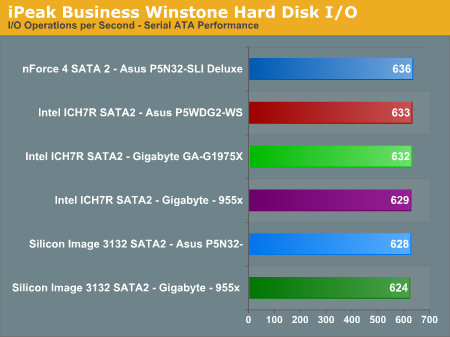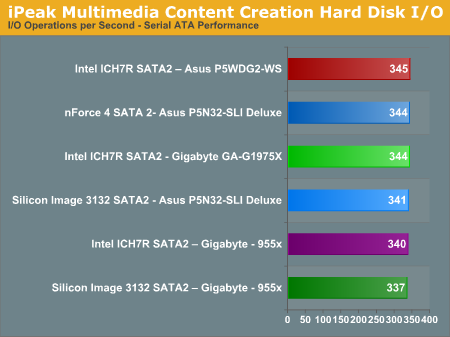Asus P5WDG2-WS: Intel 975X goes to Work
by Gary Key on December 6, 2005 12:05 AM EST- Posted in
- Motherboards
Disk Controller Performance
With the variety of disk drive benchmarks available, we needed a means of comparing the true performance of the wide selection of controllers. The logical choice was Anand's storage benchmark first described in Q2 2004 Desktop Hard Drive Comparison: WD Raptor vs. the World. The iPeak test was designed to measure "pure" hard disk performance, and in this case, we kept the hard drive as consistent as possible while varying the hard drive controller. The idea is to measure the performance of a hard drive controller with a consistent hard drive.
We played back Anand's raw files that recorded I/O operations when running a real world benchmark - the entire Winstone 2004 suite. Intel's iPEAK utility was then used to play back the trace file of all IO operations that took place during a single run of Business Winstone 2004 and MCC Winstone 2004. To try to isolate performance differences to the controllers that we were testing, we used the Maxtor MaXLine III 7L300S0 300GB 7200 RPM SATA drive in all tests . The drive was formatted before each test run and a composite average of 5 tests on each controller interface was tabulated in order to ensure consistency in the benchmark.
iPeak gives a mean service time in milliseconds; in other words, the average time that each drive took to fulfill each IO operation. In order to make the data more understandable, we report the scores as an average number of IO operations per second so that higher scores translate into better performance. This number is meaningless as far as hard disk performance is concerned as it is just the number of IO operations completed in a second. However, the scores are useful for comparing "pure" performance of the storage controllers in this case.
With the variety of disk drive benchmarks available, we needed a means of comparing the true performance of the wide selection of controllers. The logical choice was Anand's storage benchmark first described in Q2 2004 Desktop Hard Drive Comparison: WD Raptor vs. the World. The iPeak test was designed to measure "pure" hard disk performance, and in this case, we kept the hard drive as consistent as possible while varying the hard drive controller. The idea is to measure the performance of a hard drive controller with a consistent hard drive.
We played back Anand's raw files that recorded I/O operations when running a real world benchmark - the entire Winstone 2004 suite. Intel's iPEAK utility was then used to play back the trace file of all IO operations that took place during a single run of Business Winstone 2004 and MCC Winstone 2004. To try to isolate performance differences to the controllers that we were testing, we used the Maxtor MaXLine III 7L300S0 300GB 7200 RPM SATA drive in all tests . The drive was formatted before each test run and a composite average of 5 tests on each controller interface was tabulated in order to ensure consistency in the benchmark.
iPeak gives a mean service time in milliseconds; in other words, the average time that each drive took to fulfill each IO operation. In order to make the data more understandable, we report the scores as an average number of IO operations per second so that higher scores translate into better performance. This number is meaningless as far as hard disk performance is concerned as it is just the number of IO operations completed in a second. However, the scores are useful for comparing "pure" performance of the storage controllers in this case.












31 Comments
View All Comments
Gary Key - Tuesday, December 6, 2005 - link
We are still working on a way to properly show this in the graph engine.Thank you.
imaheadcase - Tuesday, December 6, 2005 - link
I saw this article 2 times put up already. anyone else seeing this?Last half a dozen reviews show up, i see people comment on them, then they disappear and come back latter. weird
wilburpan - Monday, December 5, 2005 - link
According to your Ethernet tests:Gigabyte GA-G1975X: 951.4 Mb/s
Asus P5WDG2-WS: 950.3 MB/s
Gigabyte GA-G1975X: 16.04% cpu utilization
Asus P5WDG2-WS: 23.78%
And in your text:
"The Marvell 88E8062 PCI Express Dual LAN solution exhibits slightly higher throughput along with very good CPU utilization rates. The Broadcom 5789KFB option on the Gigabyte board offers excellent throughput, but at a slightly higher CPU utilization than on other solutions."
With the data you have, it seems the exact opposite conclusion should be made.
Gary Key - Tuesday, December 6, 2005 - link
Hi,Unfortunately, our document engine had a mind of its own last night when the article went up the first time as it was not completed yet. The last couple of pages are correct now along with additional information that was not available last night. We had to wait on Asus to provide shipping drivers and Marvell firmware which changed the original scores (went down but stability increased). The new graphs were correct but my text changes had not caught up yet. We have been informed by Asus the 88E8066 chipset will actually be used on the board in the near future.
Thank you.
BrownTown - Tuesday, December 6, 2005 - link
interesting stuff for the Presler there, I eagerly await your new article :pDanDaMan315 - Monday, December 5, 2005 - link
yayVegito - Tuesday, December 6, 2005 - link
Juicy.. I just need these pcix + pcie board for an amd machine.. :)Gary Key - Tuesday, December 6, 2005 - link
We highly suggested this to Asus. ;->Pirks - Tuesday, December 6, 2005 - link
Many many years from now we'll get another Asus or any other r333w1 mobo (DFI LanParty Ultra 3.0? :) with quantum 1000 GHz CPU, UltraWideFirewire 24000, USB 8.0, built in laser keyboard link and wireless 80" display link... and a LOT more... and.......AND...
...and A FLOPPY CONNECTOR!!!
and AN LPT PORT!!!!!
and PS/2 JACKS!!!!!!
AND TWO, LISTEN TO THIS - !TWO! COM PORTS!!!!
bwahahahahahahaaaaa
I just can't look at all the museum artefacts on these so called "professional" mobos, when Macs have only USB and FW as their standard interfaces for years!
Yea I know Mac hardware is sucky/expensive, no cool gaming and stuff, but... I really understand well some of my Mac using buddies when they visit me while I'm working on one of my PC's "professional" mobos (upgrading heatsink or something), and they see one of these huge LPT connectors and they're like "WTF???!?!?"
I know noone cares about this stuff, noone will ever make decent and inexpensive legacy free PC mobo, just wanted to vent it off... thanks :)
Saist - Tuesday, December 6, 2005 - link
obviously you have never tried to run a data center, or ever bought hardware on a budget, nor that you run windows...or are you conviently forgetting that Windows has the worst in-box hardware support available and that to run many SATA drives requires installing drivers as though they are SCISI devices rather than on-chip devices.
Or that not everybody can afford to upgrade to a new laser jet / ink jet / Hp OfficeJet at every new release, and that for many a business the stock dot matrix offers the best price/performance and there is no reason to replace a perfectly functioning dot/matrix printer for something that costs a lot more to run.
or that usb support for keyboards is a little spotty in the Microsoft bootloader if you do try to run multiple versions of windows
Or that many older devices still require the com ports.
Sure, if you are building a brand new computer and have no hardware you ever intend to run again, running a legacy free system is a good idea.
But, when you only have 5% of the market at best...
it just doesn't make sense.
Sorry, but I find the laughter and your comments to be so far off base... I can only sigh and wish I had your budget to spend.